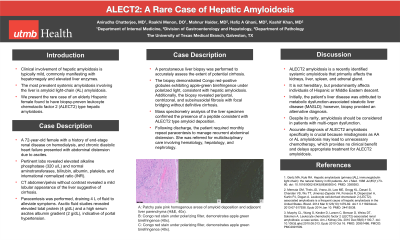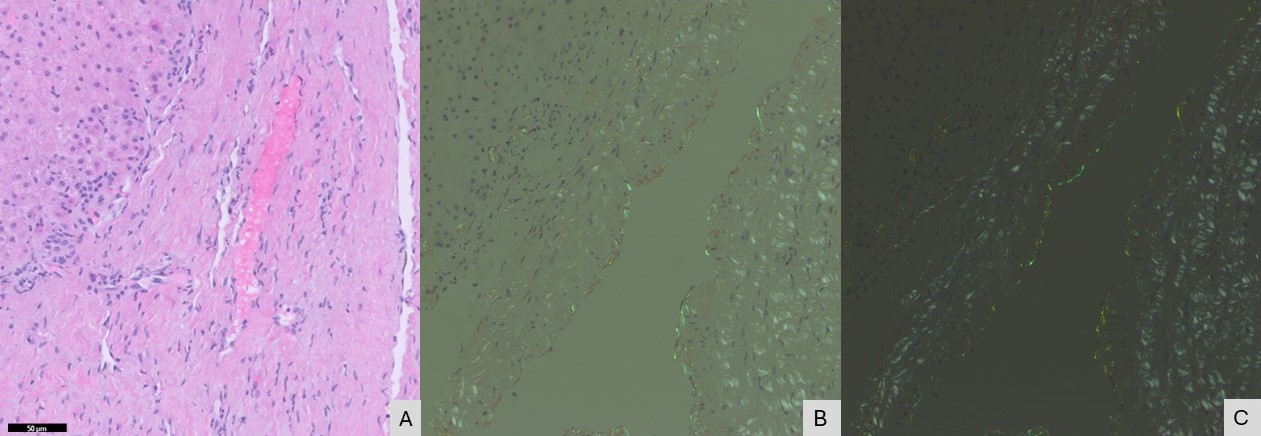Sunday Poster Session
Category: Liver
P1409 - ALECT2: A Rare Case of Hepatic Amyloidosis
Sunday, October 27, 2024
3:30 PM - 7:00 PM ET
Location: Exhibit Hall E

Has Audio

Anirudha Chatterjee, MD
University of Texas Medical Branch
Galveston, TX
Presenting Author(s)
Anirudha Chatterjee, MD, Raakhi Menon, DO, Mahnur Haider, MD, Hafiz Ghani, MD, Kashif Khan, MD
University of Texas Medical Branch, Galveston, TX
Introduction: Clinical involvement of hepatic amyloidosis is typically mild, commonly manifesting with hepatomegaly and elevated liver enzymes. The most prevalent systemic amyloidosis involving the liver is amyloid light-chain (AL) amyloidosis. We present the case of an elderly Hispanic female with biopsy-proven leukocyte chemotactic factor 2 (ALECT2) type hepatic amyloidosis.
Case Description/Methods: A 72-year-old female with a history of end-stage renal disease on hemodialysis and chronic diastolic heart failure presented with abdominal distension due to ascites. Laboratory investigations showed elevated alkaline phosphatase (320 u/L) and normal aminotransferases, bilirubin, albumin, platelets, and international normalized ratio. Abdominal computed tomography (CT) revealed a mild lobular appearance of the liver suggestive of cirrhosis. Paracentesis was performed, draining 4 L of fluid to alleviate symptoms. Ascitic fluid studies revealed elevated total protein (4 g/dL) and a high serum ascites albumin gradient (2 g/dL), indicative of portal hypertension. A percutaneous liver biopsy was performed to accurately assess the extent of potential cirrhosis. The biopsy demonstrated Congo red-positive globules exhibiting apple-green birefringence under polarized light, consistent with hepatic amyloidosis. Additionally, the biopsy revealed periportal, centrizonal, and subsinusoidal fibrosis with focal bridging without definitive cirrhosis. Mass spectrometry analysis of the liver specimen confirmed the presence of a peptide consistent with ALECT2 type amyloid deposition. Following discharge, the patient required monthly repeat paracentesis to manage recurrent abdominal distension. She was referred for multidisciplinary care involving hematology, hepatology, and nephrology.
Discussion: ALECT2 amyloidosis is a recently identified systemic amyloidosis that primarily affects the kidneys, liver, spleen, and adrenal gland. It is not hereditary but predominantly affects individuals of Hispanic or Middle Eastern descent. Initially, the patient’s liver disease was attributed to metabolic dysfunction-associated steatotic liver disease (MASLD); however, biopsy provided an alternative diagnosis. Despite its rarity, amyloidosis should be considered in patients with multi-organ dysfunction. Accurate diagnosis of ALECT2 amyloidosis specifically is crucial because misdiagnosis as AA or AL amyloidosis may lead to unnecessary chemotherapy, which provides no clinical benefit and delays appropriate treatment for ALECT2 amyloidosis.

Disclosures:
Anirudha Chatterjee, MD, Raakhi Menon, DO, Mahnur Haider, MD, Hafiz Ghani, MD, Kashif Khan, MD. P1409 - ALECT2: A Rare Case of Hepatic Amyloidosis, ACG 2024 Annual Scientific Meeting Abstracts. Philadelphia, PA: American College of Gastroenterology.
University of Texas Medical Branch, Galveston, TX
Introduction: Clinical involvement of hepatic amyloidosis is typically mild, commonly manifesting with hepatomegaly and elevated liver enzymes. The most prevalent systemic amyloidosis involving the liver is amyloid light-chain (AL) amyloidosis. We present the case of an elderly Hispanic female with biopsy-proven leukocyte chemotactic factor 2 (ALECT2) type hepatic amyloidosis.
Case Description/Methods: A 72-year-old female with a history of end-stage renal disease on hemodialysis and chronic diastolic heart failure presented with abdominal distension due to ascites. Laboratory investigations showed elevated alkaline phosphatase (320 u/L) and normal aminotransferases, bilirubin, albumin, platelets, and international normalized ratio. Abdominal computed tomography (CT) revealed a mild lobular appearance of the liver suggestive of cirrhosis. Paracentesis was performed, draining 4 L of fluid to alleviate symptoms. Ascitic fluid studies revealed elevated total protein (4 g/dL) and a high serum ascites albumin gradient (2 g/dL), indicative of portal hypertension. A percutaneous liver biopsy was performed to accurately assess the extent of potential cirrhosis. The biopsy demonstrated Congo red-positive globules exhibiting apple-green birefringence under polarized light, consistent with hepatic amyloidosis. Additionally, the biopsy revealed periportal, centrizonal, and subsinusoidal fibrosis with focal bridging without definitive cirrhosis. Mass spectrometry analysis of the liver specimen confirmed the presence of a peptide consistent with ALECT2 type amyloid deposition. Following discharge, the patient required monthly repeat paracentesis to manage recurrent abdominal distension. She was referred for multidisciplinary care involving hematology, hepatology, and nephrology.
Discussion: ALECT2 amyloidosis is a recently identified systemic amyloidosis that primarily affects the kidneys, liver, spleen, and adrenal gland. It is not hereditary but predominantly affects individuals of Hispanic or Middle Eastern descent. Initially, the patient’s liver disease was attributed to metabolic dysfunction-associated steatotic liver disease (MASLD); however, biopsy provided an alternative diagnosis. Despite its rarity, amyloidosis should be considered in patients with multi-organ dysfunction. Accurate diagnosis of ALECT2 amyloidosis specifically is crucial because misdiagnosis as AA or AL amyloidosis may lead to unnecessary chemotherapy, which provides no clinical benefit and delays appropriate treatment for ALECT2 amyloidosis.

Figure: A: Patchy pale pink homogenous areas of amyloid deposition and adjacent liver parenchyma (H&E, 40x).
B: Congo red stain under polarizing filter, demonstrates apple green birefringence (40x).
C: Congo red stain under polarizing filter, demonstrates apple green birefringence (40x).
B: Congo red stain under polarizing filter, demonstrates apple green birefringence (40x).
C: Congo red stain under polarizing filter, demonstrates apple green birefringence (40x).
Disclosures:
Anirudha Chatterjee indicated no relevant financial relationships.
Raakhi Menon indicated no relevant financial relationships.
Mahnur Haider indicated no relevant financial relationships.
Hafiz Ghani indicated no relevant financial relationships.
Kashif Khan indicated no relevant financial relationships.
Anirudha Chatterjee, MD, Raakhi Menon, DO, Mahnur Haider, MD, Hafiz Ghani, MD, Kashif Khan, MD. P1409 - ALECT2: A Rare Case of Hepatic Amyloidosis, ACG 2024 Annual Scientific Meeting Abstracts. Philadelphia, PA: American College of Gastroenterology.
